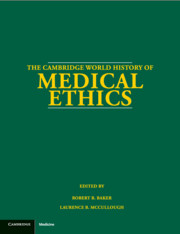Book contents
- Frontmatter
- PART I AN INTRODUCTION TO THE HISTORY OF MEDICAL ETHICS
- PART II A CHRONOLOGY OF MEDICAL ETHICS
- PART III DISCOURSES OF MEDICAL ETHICS THROUGH THE LIFE CYCLE
- PART IV THE DISCOURSES OF RELIGION ON MEDICAL ETHICS
- PART V THE DISCOURSES OF PHILOSOPHY ON MEDICAL ETHICS
- PART VI THE DISCOURSES OF PRACTITIONERS ON MEDICAL ETHICS
- PART VII THE DISCOURSES OF BIOETHICS
- PART VIII DISCOURSES ON MEDICAL ETHICS AND SOCIETY
- Ethical and Legal Regulation of Medical Practice and Research
- 46 The Medical Market place, the Patient, and the Absence of Medical Ethics in Early Modern Europe and North America
- 47 The Legal and Quasilegal Regulation of Practitioners and Practice in the United States
- 48 The Ethics of Experimenting on Animal Subjects
- 49 The Ethics of Experimenting on Human Subjects
- 50 The Historical Development of International Codes of Ethics for Human Subjects Research
- 51 International Ethics of Human Subjects Research in the Late Twentieth Century
- B Medical Ethics, Imperialism, and the Nation-State
- C Medical Ethics and Health Policy
- Appendix: Biographies: Who Was Who in the History of Medical Ethics
- Bibliography
- Index
46 - The Medical Market place, the Patient, and the Absence of Medical Ethics in Early Modern Europe and North America
from Ethical and Legal Regulation of Medical Practice and Research
Published online by Cambridge University Press: 28 May 2012
- Frontmatter
- PART I AN INTRODUCTION TO THE HISTORY OF MEDICAL ETHICS
- PART II A CHRONOLOGY OF MEDICAL ETHICS
- PART III DISCOURSES OF MEDICAL ETHICS THROUGH THE LIFE CYCLE
- PART IV THE DISCOURSES OF RELIGION ON MEDICAL ETHICS
- PART V THE DISCOURSES OF PHILOSOPHY ON MEDICAL ETHICS
- PART VI THE DISCOURSES OF PRACTITIONERS ON MEDICAL ETHICS
- PART VII THE DISCOURSES OF BIOETHICS
- PART VIII DISCOURSES ON MEDICAL ETHICS AND SOCIETY
- Ethical and Legal Regulation of Medical Practice and Research
- 46 The Medical Market place, the Patient, and the Absence of Medical Ethics in Early Modern Europe and North America
- 47 The Legal and Quasilegal Regulation of Practitioners and Practice in the United States
- 48 The Ethics of Experimenting on Animal Subjects
- 49 The Ethics of Experimenting on Human Subjects
- 50 The Historical Development of International Codes of Ethics for Human Subjects Research
- 51 International Ethics of Human Subjects Research in the Late Twentieth Century
- B Medical Ethics, Imperialism, and the Nation-State
- C Medical Ethics and Health Policy
- Appendix: Biographies: Who Was Who in the History of Medical Ethics
- Bibliography
- Index
Summary
INTRODUCTION
From the Renaissance well into the nineteenth century, no ethics particular to medicine governed the patient–practitioner relationship in Europe and North America (see also Chapters 1 and 28). Although elite university-trained practitioners wrote treatises on topics that we now consider under the rubric of medical ethics, the day-to-day relationships between healers and the sick were shaped by two sets of more general social norms. First, the structure of early modern health care provision has been likened to a medical marketplace. In such a marketplace, medicine was a commodity like any other, and so medical interactions were largely structured by the rules of commercial interchange. Second, as in other social relations of the period, both patients and practitioners appreciated the mutual obligations of patronage and deference between people of different social groups. At times, the patient was the patron, and the practitioner a client, whereas at others these roles were reversed. From the seventeenth century, patients were sometimes understood as a group deserving of special protection due to their temporary or permanent disability.
THE MEDICAL MARKETPLACE
Over the past two decades, historians have become interested in the rank-and-file of medical practitioners and in the experiences of patients rather than just the elite of medicine. As a result of this broader canvas, they have come to describe health care provision in early modern Europe and North America as a medical marketplace (see also Chapter 27). Three key features characterize this model.
- Type
- Chapter
- Information
- The Cambridge World History of Medical Ethics , pp. 531 - 539Publisher: Cambridge University PressPrint publication year: 2008



